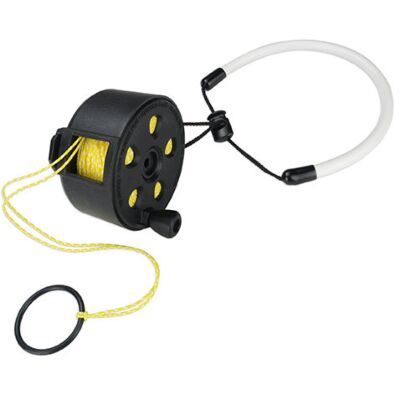AP Diving Ratchet Pocket Reel
- Enclosed hybrid design with applications as a reel or a spool
- Ratchet mechanism works in both directions, simple thumb lever to switch to free-running mode
- {150 ft | 45 m} ultra-strong Dyneema® 1.5mm (aka #18) braided line
- Compact with left or right hand operation
AP Diving Ratchet Pocket Reel
Line length is approximate.
The AP Diving Pocket Reel comes equipped with {150 ft | 45 m} of high-strength Dyneema line and features a precision-engineered ratchet mechanism that ensures smooth and controlled deployment and retrieval of the line. The Pocket Reel's unique feature is that the line is completely encased in a glass-reinforced polymer domed body, thus the line cannot slip off the reel and become tangled. The pocket reel includes a secure tie point for clips, providing versatile mounting options and also includes a wrist lanyard. With a simple winding handle and ratchet mechanism, retrieving the line is a breeze, even in challenging underwater situations. Approximately {3 in | 8 cm} in diameter by {2 in | 5cm} deep and weighing { 7 oz | 200 gm} the reel can be stowed in your BCD pocket or clipped to a D-Ring and it sits neatly in the your palm when in use. The compact enclosed design minimizes drag and interference plus ensures a comfortable grip during use.
- The on/off thumb lever to easily change between ratchet and free-running modes. Simply press down to lock-off and tap the lever to the side to release and re-engage ratchet mode. The lock-off design means that you do not have to keep your thumb on the lever in free-running mode when used as a navigation reel.
- Features a loud audible ratchet-click when winding, which aids the diver in judging ascent speed and lets other divers know you are returning or ascending.
- The ultra-strong Dyneema line is slightly buoyant so that it rises above wreckage or the seabed when used as a navigation reel – reducing entanglement and making the return journey easier.
- The dome side sits comfortably in your palm while you simply release and lock with your thumb.
- A large loop with an O-ring as a pull tab at the end of the line makes tying off a simple operation.
| Brand | AP Diving |
|---|---|
| SKU | SS-APD-REEL45M |
| Weight | 0.500000 |
Customer Reviews
 WARNING
WARNING
The manufacturer includes a wrist lanyard that we recommend be removed (or at least not actually attached to your wrist) if the reel is ever intended for use in deployment of an SMB. You should not have a reel attached to any part of your gear or use the wrist lanyard when sending an SMB to the surface. During deployment of line, the reel should be lightly held so that it is possible to easily release the entire reel if necessary.
Characteristics of Line on Dive Reels and Finger Spools
Traditionally, the line on dive reels is a braided thermoplastic fiber made from polyamide (aka Nylon and PA) or more recently polyester terephthalate (aka Dacron and PET) ; each have their pros and cons. Both are strong, but nylon has significantly more elasticity while polyester has very little stretch. In water, nylon tends to become a little 'soggy' and swell slightly thus losing about 15% of its strength, while polyester retains 100% of its strength remaining 'crisp' and resilient when wet. Polyester has better resistance to abrasion and oil products, plus it is significantly more resistant to degrading from UV exposure. Polyester also noticeably better absorbs and retains the high-visibility color dyes (Orange or Chartreuse, Which is Better?). Many divers prefer polyester line claiming it deploys 'smoother' from the reel and is noticeably stronger; other divers still prefer nylon claiming its elasticity makes it easier to handle and 'tie off' in guideline applications. A few dive equipment manufacturers have been experimenting with high performance thermoplastics such as polyethersulfone (PES) and ultra-high-molecular-weight polyethylene (UHMWPE). These newer materials are many times the strength of polyester.
| Material Trade name |
Polyethersulfone Ultrason |
UHMWPE Dyneema |
Polyester Dacron |
Polyamide Nylon |
|---|---|---|---|---|
| Dry Tenacity (cN/dtex)
|
28 - 38
|
28 - 38
|
7 - 8
|
6 - 7
|
| Elongation at break (%)
|
28
|
3.5
|
10 - 16
|
16 - 27
|
| Specific gravity (g/cm
3)
|
1.37
|
0.98
|
1.38
|
1.15
|
| Melting point (°C)
|
227
|
149
|
260
|
220
|
| Abrasion resistance
|
excellent
|
very good
|
excellent
|
very good
|
| UV resistance
|
poor
|
very good
|
excellent
|
good
|
| Salt resistance
|
excellent
|
excellent
|
good
|
good
|
| Resistance to oil products
|
excellent
|
excellent
|
excellent
|
good
|
| Knot strength (%)
|
55 - 60
|
35 - 50
|
55 - 60
|
60 - 65
|
The size code numbers that describe the diameters of nylon guideline used in cave diving are from an archaic nomenclature for what is termed "twine" (braided string) and each # code describes an approximate thickness range in fractions of an inch. There does not appear to be an established standard (if you know of one, please tell us); size charts vary depending on the cordage manufacturers who each publish their own version for their products. There are four sizes normally seen on guideline reels: #36 and #24 are most common for nylon with #21 and #18 most common for polyester because it is stronger. The thinner the line the more length that can be fit on a given size reel or conversely the smaller the size of the reel for a given length. However, #18 is approaching the minimum diameter practical for manageable line handling in diving applications.




